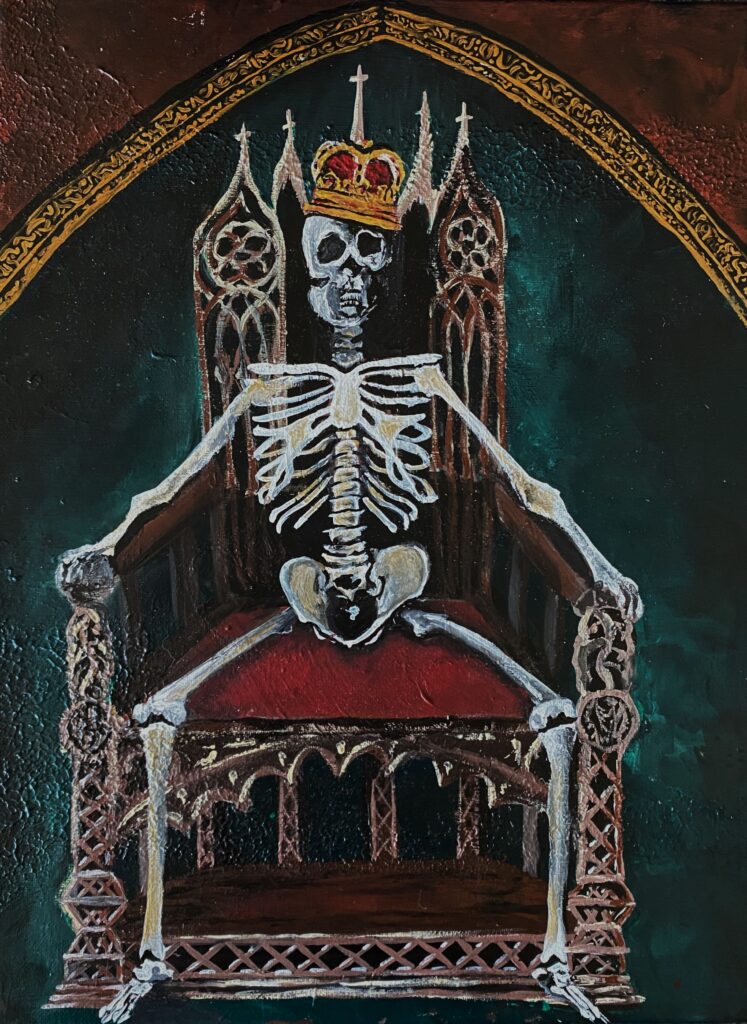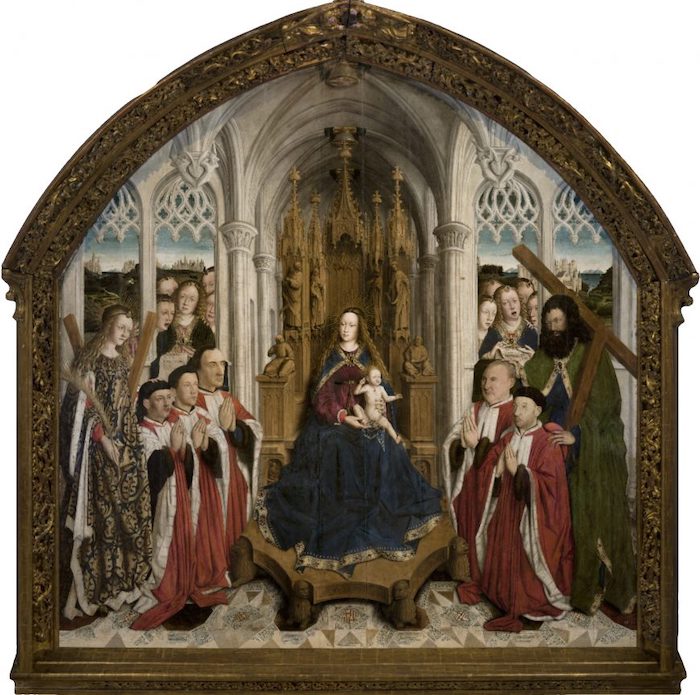
Empty Promises:
An Analysis of 15th Century Castilian Courtly Celebrations
Rachael Holmes
University of Northern British Columbia
HIST 365
Dr. Wessell Lightfoot
June 21, 2021
Fifteenth century Castile, Spain, experienced several alterations to what the role of a king meant for its nation. The title of the king came with all the luxuries of courtly events, marriages and war, however, the position of the king within these proceedings became more ceremonial rather than managerial. For this creative project, I have painted an image of a skeleton sitting on the throne representing the hollowness of royalty in Castile. This paper will be looking at one case study of a king that ruled during this transitional century named King Henry IV of Castile, otherwise known as “the Impotent.” This paper will discuss two courtly events that took placed during his reign, his first marriage and a Christmas festival. What can be argued using these examples is that Henry IV produced a false image of strength, wealth and grandness using these celebrations, but did little outside of these events to prove such characteristics existed in himself, and in his nation.
The painting I produced is done with acrylic paint on canvas. I chose this medium as it is something I am skilled in and allowed me the flexibility to blend new idea’s into the piece throughout the research process (acrylic paint is a forgiving medium, if something needs to be changed, enhanced or added, I would have been able to do so). While doing some external research about the time frame my paper is looking at, architecture was crossed between the withstanding Islamic curves and design, and merging with the Gothic form of art that started to develop in the 15th century. Knowing this, I wanted to produce an image that was framed with Islamic textures, and have the throne more Gothic. An image of reference that represents this transitional period is Valencia and Lluís Dalmau, Virgin of the Councillors, 1443-1445. This painting is done with oil and oak wood, as it captures in the distance the arched roof that Islamic architecture often had, and upfront, the Christian’s praying for Virgin Mary. The figure of the skeleton with a crown on its head is meant to be a representation of the emptiness of royalty. That although a king sits on the throne, wears expensive clothing, and are showcased as prestige people, by the 15th century, that image was used as propaganda not precision. How these claims can be supported is through the analysis of two events; King Henry IV of Castile, first wedding, and 1462s, Christmas festival.
King Henry IV was only 15 when he was set to marry Donã Blanca, a princess of Navarre, Portugal. This arrangement was done as Henry IV was concerned with gaining an alliance with Portugal as the threat of the kingdom of Aragon was approaching. The Preparations for a Royal Wedding” in 1440 was extravagant. The Portuguese were welcomed into Castile with “one hundred mem-at-arms, their horses covered in cloth, their helmets adorned with plumes… [split between the road] they began to fight…” as part of the entrance performances. This display set the tone for what this ensuing marriage meant; that people will talk about how impressive, how strong and rich Castile was, and now, aligning with Portugal surrounding their interior enemies. It was a display of power. An interesting fact about this primary document is that it never mentioned Henry IV partaking in these events, just count Haro, the man who organized every event. This made me question how involved the King was when it came to his and his regime’s image. Again showcasing that this wedding might have been in the initial stages of separating the king’s involvement in external affairs; external affairs meaning, marriages, presentation, developing alliances and propaganda. After the four days of dinning, dancing, hunting, fishing and more, the two royals were wed. Unfortunately, King Henry IV was unable to consummate the marriage and the two divorced three years after their marriage. Scholars predict through both the annulment of the marriage and medieval plays written about him, that King Henry IV was homosexual. This is where his nickname “The Impotent” comes to be important for this research. Henry IV won one war battle in his early years, but never again after that point; he was unable to consummate his marriage, his “foreign and domestic oppositions thwarted all his actions, and he lacked political sagacity and personal deviousness to remake events to suit his own interests… many in Castile believed he could not have fathered Juana who had a stronger claim to the throne.” Events were all this King had, empty, meaningless events that he attached his crown to instead of the issues infant of him.
The second primary source is about a Christmas festival ran by constable Miguel Lucas de Iranzo. He was of low birth and had climbed his way up into the King’s trusted circle. The set up if the festival was more traditional where they reenacted the nativity scene, ate, and danced the rest of the evening. One point stood out the most, that the castle was light up with “so many torches and lanterns [lighting his path] that, because the light was so intense, it seemed as at midday.” This presentation resembles how people in the nativity scene were all brought to the birth or Jesus by following the bright light in the sky. If this was the intention of the king and count then it is a bold statement at that. To infer that Castile is like Bethlehem for people is a statement that directly strikes at their surrounding enemies. Although this imagery is rather aggressive, actual actions beyond the performance were never taken. King Henry IV developed the cover for a book but never wrote the actual chapters for it. Do not judge a book by its cover is a phrase that perfectly describes the kings rule; he presented an argument without any evidence to back up his claims.
Although this paper only analyzed one medieval king in the 15th century, further research I had done shared that the ruler before him King John II of Castile shared similar issues with actually taking action. Although John II was the longest Castilian reign of 48 years, he was not a particularly capable monarch. My artistic representation of the research done it attempting to represent the fragmentation, and breakdown of royal power. Using the time-frames amalgamation of Islamic textures and Gothic art, I produced a blended image of architecture. To reiterate the argument, the monarchy severed a more ceremonial purpose to governance, unlike earlier Castilian history where the crown was the absolute leader. The 15th century was a transitional century where kings like Henry IV were unable to hold onto the power the crown once had and hid behind celebrations as a means of control. Similar to what Mccall’s analysis behind medieval clothing, it is a “corpse or a mass of lifeless cloth without the body to fill it out,” like Henry’s festivities, they were inanimate to what his actual rule was.
Bibliography
Campbell, Jodi. “A King Travels: Festive Traditions in Late Medieval and Early Modern Spain, by Teofilo F. Ruiz.” JSTOR 128, no. 535 (2013): 1558-560.
Constable, Olivia Remie. “Christmas Festivities in Jaén.” Translated from Castilian by Ronald Surtz. In Medieval Iberia: Readings From Christian, Muslim, and Jewish Sources, 452-454. Ed. 2. Philadelphia: University of Pennsylvania Press, 2012.
Constable, Olivia Remie. “Pageants and Festivities in Castile: Preparation for a Royal wedding.” Translated by Teofilo Ruiz. In Medieval Iberia: Readings From Christian, Muslim, and Jewish Sources, 449-451. Philadelphia: University of Pennsylvania Press, 2012.
“Fifteenth-century Spanish Painting, an Introduction (article).” Khan Academy. Accessed June 22, 2021. https://www.khanacademy.org/humanities/renaissance-reformation/xa6688040:spain-portugal-15th-16th-century/xa6688040:15th-century-spain/a/fifteenth-century-spanish-painting-an-introduction.
Mccall, Timothy. “Materials for Renaissance Fashion.” Renaissance Quarterly Vol. 70, No. 4 (2017), 1449-1464.
Phillips, William David, and Townsend Miller. “Henry IV of Castile: 1425-1474.” The Hispanic American Historical Review 53, no. 1 (1973): 150.


Recent Comments